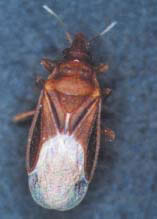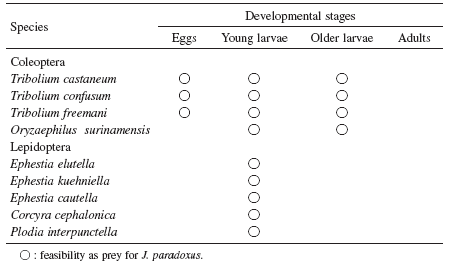Predatory ability of Joppeicus paradoxus Puton, a predator of stored-product insect pests
Description
[Objectives]
Methyl bromide (MeBr) is the one of the most useful chemical agents for insect control in stored products. Fumigation with MeBr, however, may have negative effects in terms of human health. More importantly, the use of MeBr has been found to lead to ozone depletion, and for this reason will be banned from use in most cases by 2005 in developed countries and by 2015 in developing countries. It is therefore urgent that we develop alternative methods and adopt integrated pest management (IPM) techniques. Biological control is thus being regarded with increasing interest, due to its nontoxic, human-safe, environment-friendly properties. The use of natural enemies (predators and parasitoids) in controlling stored-product insect pests has also been studied by various researchers worldwide.
The predacious bug, Joppeicus paradoxus is the only member of the Joppeicidae family (Fig. 1). There have been records of J. paradoxus in the Middle East and northern Africa, Egypt, Sudan, Ethiopia and Israel. Recently, J. paradoxus was also discovered in a stored-product environment, in a bean storage area in Thailand, which was coincidentally, one of the research sites for our project.
[Results]
In order to utilize J. paradoxus as a natural enemy, feasible insect pests in food-storing environments must be examined. Feasibility was checked for nine species of insect pests of the orders Coleoptera and Lepidoptera (Table 1). According to the results, J. paradoxus is able to attack many species of stored-product insect pests and prefers insect pests in their young larval stages to ones in their later stages of life.
The predatory ability of J. paradoxus towards two stored-product insect pests, Tribolium confusum in its lastinstar larval stage, and Plodia interpunctella in its second instar larval stage, were examined. J. paradoxus adults were left unfed for three days and then placed individually into plastic containers containing different prey densities. The assay was carried out at 30°C for 1 day. The predation index increased with the concentration and saturation of prey species (Tables 2 and 3). Especially toward the last instar larvae of T. castaneum, the mean predation activity index was six, which is three-fold higher than the mean predation index of Xylocoris flavipes, which is already on the U.S. market. These results suggest that J. paradoxus has a higher potential as natural enemy. A joint patent application between JIRCAS, the National Food Research Institute (NFRI), and Thai Department of Agriculture (DOA) for the elucidation of J. paradoxus as a bio-insecticide towards stored product insect pests and its application methodologies was submitted to the Japan Patent Office in January 2004.
Figure, table
-
Fig. 1. An adult female Joppeicus paradoxus, known by its common Thai name, "Puton." Body length: 3 mm -
Table 1. Prey range of J. paradoxus on stored-product insect pests.
-
Table 2. Mean values of predation on last-instar larvae of T. castaneum.
-
Table 3. Mean values of predation on second-instar larvae of P. interpunctella.
- Affiliation
-
National Food Research Institute
Department of Agriculture Thailand
- Classification
-
Technical A
- Term of research
-
FY2003 (FY2002-2004)
- Responsible researcher
-
MIYANOSHITA Akihiro ( National Food Research Institute )
IMAMURA Taro ( National Food Research Institute )
VISARATHANONTH Porntip ( Department of Agriculture Thailand )
SUKPRAKARN Chuwit ( Department of Agriculture Thailand )
- ほか
- Publication, etc.
-
Brower, J.H., Smith, L., Vail, P.V. and Flinn, P.W. (1996): Biological control. Integrated Management of Insects in Stored Products, eds. B. Subramaniyam and D. W. Hagstrum Mercel Dekker Inc., New York, 223-283.
China, W.E. (1955): A reconsideration of the systematic position of the family Joppeicidae Reuter (Hemiptera- Heteroptera), with notes on the phylogeny of the suborder. Ann. Mag. Nat. Hist. 12 (8), 353-370.
Davis, N.T. and Usinger, R.L. (1970): The biology and relationships of the Joppeicidae (Heteroptera). Ann. Entomol. Soc. Am., 63, 577-587.
Nakakita, H. (1999): Role of biological control in grain storage in the tropics. The 5th JIRCAS International Symposium Series No.7, eds.Y. Nawa et al., Postharvest Technology in Asia. JIRCAS, Tsukuba, Japan, 73-86.
Stys, P. (1971): Distribution and habitats of Joppeicidae (Heteroptera). Acta faun. ent. Mus. Nat. Paragae, 14, 199-208.
Visarathanonth, P., Nakakita, H. and Sittisuang, P. (1994): Role of natural enemies in the regulation of storedproduct insect populations in rice storages in Thailand. JIRCAS journal, 1, 1-7.
- Japanese PDF
-
2003_22_A3_ja.pdf1.88 MB
- English PDF
-
2003_22_A4_en.pdf60.47 KB




